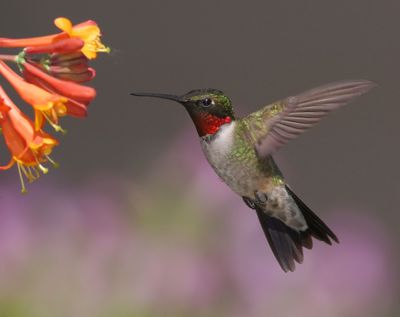Study finds hummingbirds migrate earlier
Phenomenon could mean less food available at nesting time

CHARLESTON, S.C. – Ruby-throated hummingbirds are migrating to North America weeks earlier than in decades past, and research indicates that higher temperatures in their winter habitat may be the reason.
Researchers say the early arrival could mean less food at nesting time for the tiny birds that feed on insect pests, help pollinate flowers and are popular with birdwatchers.
Scientist Ron Johnson and colleagues from Clemson University; Taylor University in Upland, Ind.; and the University of Nebraska last month published an article on the migration of the hummingbirds in The Auk, the Journal of the American Ornithologists Union.
The birds, which weigh little more than a nickel, fly hundreds of miles over the Gulf of Mexico from their wintering grounds in Central America to arrive in North America. The research compared data on their first arrival times from 1890 to 1969 with arrival times during the past 15 years or so.
The comparison found that the birds are arriving in North America 12 to 18 days earlier than in the past.
Jason Courtier of Taylor University said the historical data on hummingbirds is based on government surveys from about 3,000 naturalists around the country who recorded the first spring arrival time of bird species over the decades.
About 6 million such records exist and are being scanned into computer databases by the North American Bird Phenology Program.
The research compared the historical documents with about 30,000 recent records on hummingbird arrivals. Scientists say the earlier arrival times could be problematic for hummingbirds, of which there are an estimated 7 million.
“With any bird that migrates over long distances, it’s good to show up at the nesting grounds at a good time when you can set up a territory and build your nest and when the young come along there will be a lot of food available,” Johnson said.
“You want to be there ideally right when the food becomes available at its peak so the young ones will have enough food.”
James Van Remsen, the curator of birds at the Museum of Natural Science at Louisiana State University, said that while he had not seen the hummingbirds research, a wide body of literature shows other species of birds flying north earlier in both North America and Europe.
But he added that sometimes too much emphasis is placed on the earliest date a bird appears. It could reflect a couple of extremely early arrivals, he said.
“What really counts, biologically, is whether the peak period of migration has actually changed,” he said. “That is what would most likely affect population biology.”